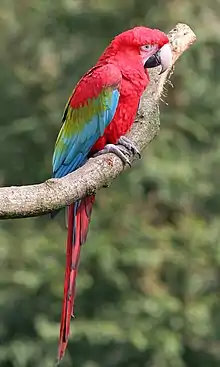Psittacofulvin
Psittacofulvin pigments, sometimes called psittacins[1] are responsible for the bright-red, orange, and yellow colours specific to parrots.[2] Psittacofulvin is suspected to be enzymatically derived from carotenoids, which are the pigments other birds use to achieve red and yellow coloring.[3] They consist of linear polyenes terminated by an aldehyde group.[4] Colourful feathers with high levels of psittacofulvin resist feather-degrading Bacillus licheniformis better than white ones.[5]

Both carotenoids and psittacofulvins have narrow-band absorbance spectra, reflecting pale yellow or red pigmentary colours, making them difficult to distinguish between using spectral measurements. However, there are differences between them when researched spectroscopically. The carotenoid and psittacofulvin yellows are very similar, but the red parrot pigment offers an advantage: it creates a more deep-red color when compared to astaxathin, the pigment's counterpart in most other birds.
Birds have tetrachromatic vision, which means that they have four types of cone cells with peak sensitivities to longwave (l), mediumwave (m), shortwave (s), and ultraviolet (uv) or violet (v) light as well as transparent oil droplets made of carotenoid filters (with mainly the pigments galloxanthin, zeaxanthin, and astaxanthin) that refine spectral sensitivities of the l, m, and s cone-types.[3][6] These filters in front of the photoreceptors tune their spectral sensitivity to longer wavelengths. Birds have yet another spectral filter allowing them to absorb wavelengths in the far UV wavelength range.
Psittacofulvins in parrots and carotenoids in passerines have nearly the same range of colors, but neither pigment is found in the immediate common anscestor of these two groups. Parrots even have a concentration of carotenoids in their blood. This implies that both groups convergently evolved red, orange, and yellow pigmentation and that parrots did not evolve psittacofulvin to avoid the use of carotenoids.[6]
References
- Feinstein, Julie. "Where feather colors come from: Why cardinals are red and grackles are shiny". Birdwatching Daily. Retrieved 24 December 2020.
- J. F. Masello, T. Lubjuhn, P. Quillfeldt (2008). Is the structural and psittacofulvin-based coloration of wild burrowing parrots Cyanoliseus patagonus condition dependent? Journal of Avian Biology, Volume 39, Number 6, November 2008 , pp. 653-662(10), doi:10.1111/j.1600-048X.2008.04417.x
- Tinbergen, J.; Wilts, B. D.; Stavenga, D. G. (2013-12-01). "Spectral tuning of Amazon parrot feather coloration by psittacofulvin pigments and spongy structures". Journal of Experimental Biology. 216 (23): 4358–4364. doi:10.1242/jeb.091561. ISSN 0022-0949. PMID 24031051.
- Stradi, R.; Pini, E.; Celentano, G. (2001). "The chemical structure of the pigments in Ara macao plumage". Comparative Biochemistry and Physiology Part B: Biochemistry and Molecular Biology. 130 (1): 57–63. doi:10.1016/s1096-4959(01)00402-x. PMID 11470444.
- Edward H. Burtt, Max R. Schroeder, Lauren A. Smith, Jenna E. Sroka, Kevin J. McGraw (2010): Colourful parrot feathers resist bacterial degradation, Biology Letters, The Royal Society, doi:10.1098/rsbl.2010.0716.
- Stoddard, Mary Caswell; Prum, Richard O. (2011-09-01). "How colorful are birds? Evolution of the avian plumage color gamut". Behavioral Ecology. 22 (5): 1042–1052. doi:10.1093/beheco/arr088. ISSN 1045-2249.
